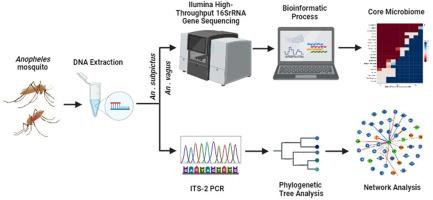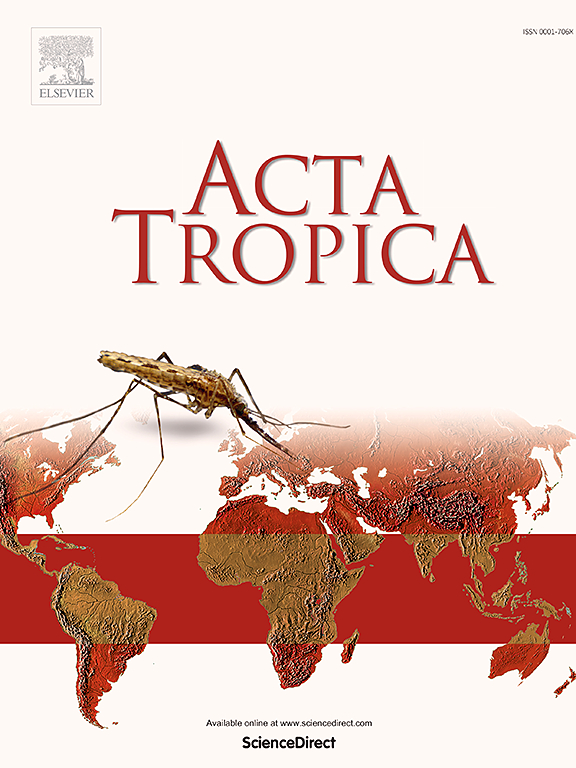The genetic composition of Anopheles mosquitoes and the diverse population of gut-microbiota within the Anopheles subpictus and Anopheles vagus mosquitoes in Tamil Nadu, India
IF 2.1
3区 医学
Q2 PARASITOLOGY
引用次数: 0
Abstract
In recent days, in tropical and subtropical regions, secondary vectors of Anopheles mosquitoes are becoming more important in transmitting diseases to humans as primary vectors. Various molecular techniques have separated closely related Anopheles subpictus and Anopheles vagus mosquitoes based on their diversity with other mosquito species. Despite their widespread distribution, the An. subpictus and An. vagus mosquitoes, which carry Plasmodium in their salivary glands, were not considered primary malaria vectors in India. An. vagus mosquitoes are zoophilic and physically similar to An. subpictus. We intend to identify An. subpictus and An. vagus mosquito's sister species based on their Interspaced Transcribed Region-2 (ITS2). We isolated the midgut gDNA from each mosquito and used ITS2-PCR and Sanger sequencing to characterize the mosquito species. BioEdit software aligned the sequences, and MEGA7 built a phylogenetic tree from them. According to this study, the information gathered from these mosquito samples fits the An. subpictus species A form and the An. vagus Indian form. Furthermore, gut microbiome plays an important role in providing nutrients, immunity, and food processing, whereas mosquitoes' midgut microbiota changes their hosts and spreads illnesses. So, we used the Illumina sequencer to look at the gut microbiome diversity of An. subpictus and An. vagus mosquitoes using 16S rRNA-based metagenomic sequencing. Both mosquito species had an abundant phylum of Pseudomonadota (Proteobacteria), Bacillota, Bacteroidota, and Actinomycetota in their gut microbiomes. Notably, both mosquito species had the genus Serratia in their gut. In the subpictus midgut, the genus of Haematosprillum bacteria was dominant, whereas in the vagus mosquito, the genus of Salmonella was dominant. Notably, current research has observed the Sodalis spp. Bacterial genus for the first time.

印度泰米尔纳德邦按蚊的基因组成以及亚按蚊和按蚊肠道微生物群的多样性。
近来,在热带和亚热带地区,按蚊的次级传播媒介在向人类传播疾病方面正变得像一级传播媒介一样重要。各种分子技术根据亚按蚊(Anopheles subpictus)和按蚊(Anopheles vagus)与其他蚊子物种的多样性,将这两种密切相关的蚊子区分开来。尽管亚按蚊和迷走蚊分布广泛,但它们的唾液腺中携带疟原虫,在印度并不被认为是疟疾的主要传播媒介。迷走蚊具有嗜动物性,与亚疟蚊体形相似。我们打算根据它们的间距转录区-2(ITS2)来确定亚爪蝇蚊和迷走蚊的姊妹种。我们分离了每只蚊子的中肠 gDNA,并使用 ITS2-PCR 和 Sanger 测序来确定蚊子的种类。BioEdit 软件对序列进行了比对,MEGA7 据此构建了系统发生树。根据这项研究,从这些蚊子样本中收集到的信息符合亚型疟蚊(An. subpictus species A form)和印度型疟蚊(An. vagus Indian form)。此外,肠道微生物群在提供营养、免疫力和食物加工方面发挥着重要作用,而蚊子的中肠微生物群会改变宿主并传播疾病。因此,我们利用Illumina测序仪,使用基于16S rRNA的元基因组测序技术,研究了亚疟蚊和迷走蚊的肠道微生物组多样性。这两种蚊子的肠道微生物组中都有丰富的假单胞菌门(蛋白菌门)、芽孢杆菌门、类杆菌门和放线菌门。值得注意的是,两种蚊子的肠道中都有沙雷氏菌属。在亚目蚊子的中肠中,血吸虫属细菌占主导地位,而在迷走蚊子中,沙门氏菌属细菌占主导地位。值得注意的是,目前的研究首次观察到了索达利属细菌。
本文章由计算机程序翻译,如有差异,请以英文原文为准。
求助全文
约1分钟内获得全文
求助全文
来源期刊

Acta tropica
医学-寄生虫学
CiteScore
5.40
自引率
11.10%
发文量
383
审稿时长
37 days
期刊介绍:
Acta Tropica, is an international journal on infectious diseases that covers public health sciences and biomedical research with particular emphasis on topics relevant to human and animal health in the tropics and the subtropics.
 求助内容:
求助内容: 应助结果提醒方式:
应助结果提醒方式:


